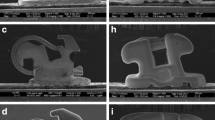Abstract
In Begg and KB techniques, the kinetic frictional force generated between their characteristic orthodontic appliances at posterior sites and the orthodontic wire affects the efficiency of tooth movement. We compared the kinetic frictional force between the recent orthodontic appliances for posterior sites: the by-pass loop-KB buccal tube system (loop-KB tube system) and the conventional by-pass clamp-round buccal tube system (clamp-round tube system), and elucidated the frictional properties of the loop-KB tube system. We used 016"/018" round wires (016/018 round) and 022" × 016" ribbon wire (022 ribbon) with anchorage bend/curve applied. The results obtained were as follows:
-
1)
The kinetic frictional energy was significantly larger in the loop-KB tube system than in the clamp-round tube system for all the degrees of anchorage bend with 016/018 round, and not significant between in both systems with 022 ribbon.
-
2)
With 016/018 round, the kinetic frictional energy became larger with the increase of the degree of anchorage bend in two systems.
Similar content being viewed by others
References
Begg PR: Light arch wire technique, Am J Orthodontics,47: 30–48, 1961.
Kameda A: An outline of the revised Begg technique & tip edge system (KB technique), Jpn J BEGG Orthod,11: 1–22, 1989.
Begg PR and Kesling PC: Begg orthodontic theory and technique, 3rd ed, Saunders WB Company, Philadelphia, 1977, 87–141, 222–282.
Andreasen GF and Quevedo FR: Evaluation of friction forces in the 0.022×0.028 edgewise bracketin vitro, J Biomech,3: 151–160, 1970.
Kamiyama T and Sasaki T: Friction and width of brackets, J Jpn Orthod Soc,32: 286–289, 1973.
Peterson L, Spencer R and Andreasen G: A comparison of friction resistance of nitinol and stainless steel wire in edgewise brackets, Quintessence Int,13: 563–571, 1982.
Baker KL, Nieberg LG, Weimer AD and Hanna M: Frictional changes in force values caused by saliva substitution, Am J Orthod Dentofac Orthop,91: 316–320, 1987.
Pratten DH, Popli K, Germane N and Gunsolley JC: Frictional resistance of ceramic and stainless steel orthodontic brackets, Am J Orthod Dentofac Orthop,98: 398–403, 1990.
Prososki RR, Bagby MD and Erickson LC: Static frictional force and surface roughness of nickeltitanium arch wires, Am J Orthod Dentofac Orthop,100: 341–348, 1991.
Frank CA and Nikolai RJ: A comparative study of frictional resistances between orthodontic bracket and arch wire, Am J Orthod,78: 593–609, 1980.
Garner LD, Allai WW and Moore BK: A comparison of frictional forces during simulated canine retraction of a continuous edgewise arch wire, Am J Orthod Dentofac Orthop,90: 199–203, 1986.
Stannard JG, Gau JM and Hanna MA: Comparative friction of orthodontic wires under dry and wet conditions, Am J Orthod,89: 485–491, 1986.
Tidy DC: Frictional forces in fixed appliances, Am J Orthod Dentofac Orthop,96: 249–254, 1989.
Drescher D, Bourauel C and Schumacher H: Frictional forces between bracket and arch wire, Am J Orthod Dentofac Orthop,96: 397–404, 1989.
Kapila S, Angolkar PV, Duncanson Jr MG and Nanda RS: Evaluation of friction between edgewise stainless steel brackets and orthodontic wires of four alloys, Am J Orthod Dentofac Orthop,98: 117–126, 1990.
Angolkar PV, Kapila S, Duncanson Jr MG and Nanda RS: Evaluation of friction between ceramic brackets and orthodontic wires of four alloys, Am J Orthod Dentofac Orthop,98: 499–506, 1990.
Endo T, Horii K, Yasuda K and Kameda A: A study on the frictional properties of low friction bracket, J Jpn Orthod Soc,53: 515–521, 1994.
Vaughan JL, Duncanson Jr MG, Nanda RS and Currier GF: Relative kinetic frictional forces between sintered stainless steel brackets and orthodontic wires, Am J Orthod Dentfac Orthop,107: 20–27, 1995.
Oka K, Endo T, Wada H, Minegishi T, Akashiba T, et al.: A study on frictional characteristics of KB horizontal brackets — A comparative study of kinetic frictional forces to be caused between various kinds of brackets and wires—, Shigaku,77: 1458–1469, 1989.
Oka K, Endo T, Akashiba T, Kawashima F and Kameda A: A study on kinetic frictional forces between various wires and by-pass clamp, by-pass loop, two buccal tubes used in the KB technique, Shigaku,80: 755–769, 1992.
Creekmore TH: The importance of interbracket width in orthodontic tooth movement, J Clin Orthod,10: 530–534, 1976.
Author information
Authors and Affiliations
Rights and permissions
About this article
Cite this article
Endo, T., Kosuge, N., Kuzuya, H. et al. A study on kinetic frictional properties in Begg/KB orthodontic appliances at posterior sites. Shigaku = Odontology 85, 379–384 (1997). https://doi.org/10.1007/BF03039035
Received:
Issue Date:
DOI: https://doi.org/10.1007/BF03039035




